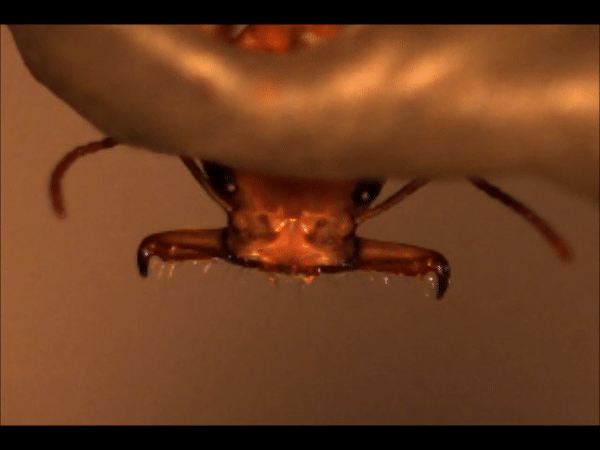
Our research capitalizes on two unique aspects of ant biology of to address fundamental questions in ecology, behavior and evolution: their social organization and their developmental plasticity. The separation of “reproductive” and “somatic” individuals into castes (queens versus workers) has resulted in remarkable levels of morphological variation in workers both within and among species. We are therefore also interested in understanding how this variation influences their ecology and performance. Below we highlight three primary research areas of the lab:
Evolution and biomechanics of trap-jaw ants
A range of animal taxa have evolved suites of morphological and behavioral specializations for self-propelled rapid-strike attacks on prey. These extreme strike abilities are among the fastest biological movements ever recorded and may be the results of co-evolutionary predator-prey arms races. What are the processes underlying the transition from a generalized function to a specialized evolutionary adaptation? We are addressing this question using “trap-jaw” ants. “Trap-jaws” have independently evolved multiple across four subfamilies of ants. In addition to being very effective at capturing prey, some species can use their over-sized jaws to propel themselves into the air. Advances in measurement and video-graphic technologies allow the characterization of these incredibly fast movements with improved precision resulting in the characterization of novel mechanisms for energy storage, amplification and release. The comparative nature of this system also allows for the examination of multiple, independent origins of trap-jaw morphology as well as variation in form and function within each origin.
- Gibson, J.C., et al. 2018. Mandible strike kinematics of the trap-jaw ant genus Anochetus Mayr (Hymenoptera: Formicidae). Journal of Zoology 306:119-128.
- Larabee, F.J., et al. 2018. Snap-jaw morphology is specialized for high-speed power amplification in the Dracula ant, Mystrium camillae. Royal Society Open Science 5:181447.
- Larabee, F.L., et al. 2017. Performance, morphology, and neuronal control of spring-loaded mandibles in the trap-jaw ant Myrmoteras (Hymenoptera: Formicidae). Journal of Experimental Biology 220:3062-3071.
- Larabee, F.J., et al. 2016. Molecular phylogenetics and diversification of trap-jaw ants in the genera Anochetus and Odontomachus (Hymenoptera: Formicidae). Molecular Phylogenetics and Evolution 103:143-154.
- Larabee, F.J. and A.V. Suarez. 2014. The evolution and functional morphology of trap-jaw ants. Myrmecological News 20:25-36.

Polymorphism and specialization in ant societies
Body size is a fundamental life history trait affecting nearly every facet of an organism’s biology. As with other life history traits, investment into body size is constrained by tradeoffs. For example, if resources are limited, an organism may have to choose between investing in more offspring or larger offspring. For social insects, this allocation can influence the ecological success of a colony. Moreover, many ants have polymorphic worker castes allowing colonies to invest in specialized worker morphology (e.g. soldiers). We are interested in examining how body size and its variation in ants are constrained phylogenetically, and how worker polymorphism may contribute to ecological success.
- Wills, B.D., et al. 2018. Correlates and consequences of worker polymorphism in ants. Annual Review of Entomology 63:575-598.
- Holley, et al. 2016. Subcaste-specific evolution of head size in the ant genus Pheidole. Biological Journal of the Linnean Society 118:472-485.
- Wills, et al. 2015. Effects of nutrition on investment in worker number, size, and condition in a polymorphic social insect. PLoS ONE 10(7): e0132440.
- Smith, C.R., et al. 2015. How do genomes create novel phenotypes? Insights from the loss of the worker caste in ant social parasites. Molecular Biology and Evolution 32:2919-2931.
- Smith, C.R., and A.V. Suarez. 2010. The trophic ecology of castes in Pogonomyrmex badius colonies. Functional Ecology 24:122-130.

Biological Invasions
A major challenge of invasion biology lies in developing a predictive understanding of invasion processes. This challenge is further complicated as characeristics that promote success may be species specific and/or change during different stages of invasion. Subsequently, our research on invasive ants is both comparative across species, and among distinct stages of invasion: opportunity, establishment and spread. We also highlight the importance of comparing the biology of introduced species between native and introduced populations including their behavior, social structure, and trophic ecology.
- Suhr, E.L., et al. 2019. Ant interceptions reveal roles of transport and commodity in identifying biosecurity risk pathways into Australia. NeoBiota 53:1-24.
- Tseng, S.-P., et al. 2019. Invasion and infection: mitochondrial diversity and Wolbachia selective sweep of a globally distributed invasive ant. Frontiers in Genetics 10:838.
- Felden, A., et al. 2018. Behavioral variation and plasticity along an invasive ant introduction pathway. Journal of Animal Ecology 87:1653-1666.
- Lester, P.J., et al. 2017. Symbiotic bacterial communities in ants are modified by invasion pathway bottlenecks and alter host behavior.Ecology 98:861-874.
- Gotzek, D., et al. 2015. Global invasion history of the tropical fire ant: a stowaway on the first global trade routes. Molecular Ecology 24:374-388.

